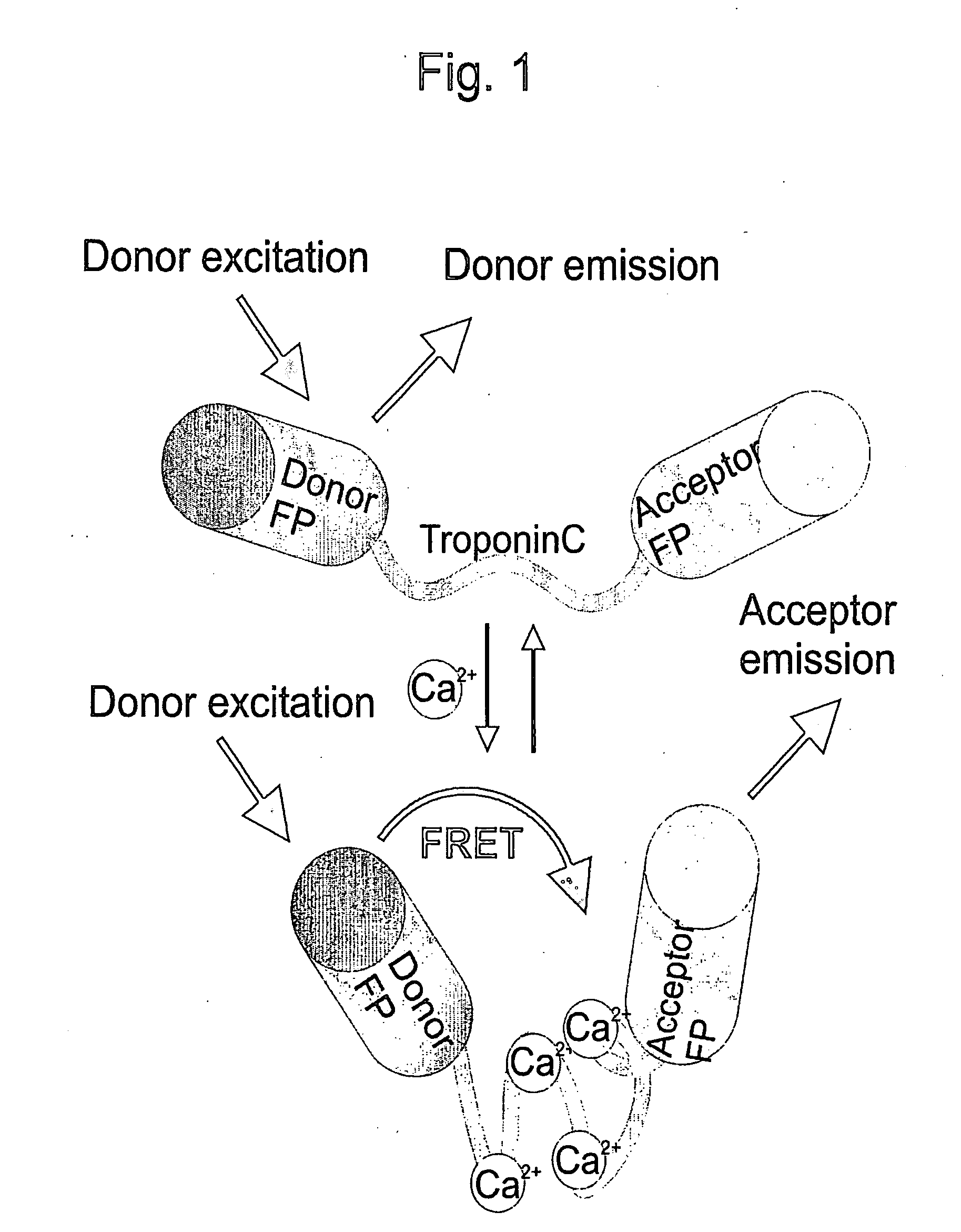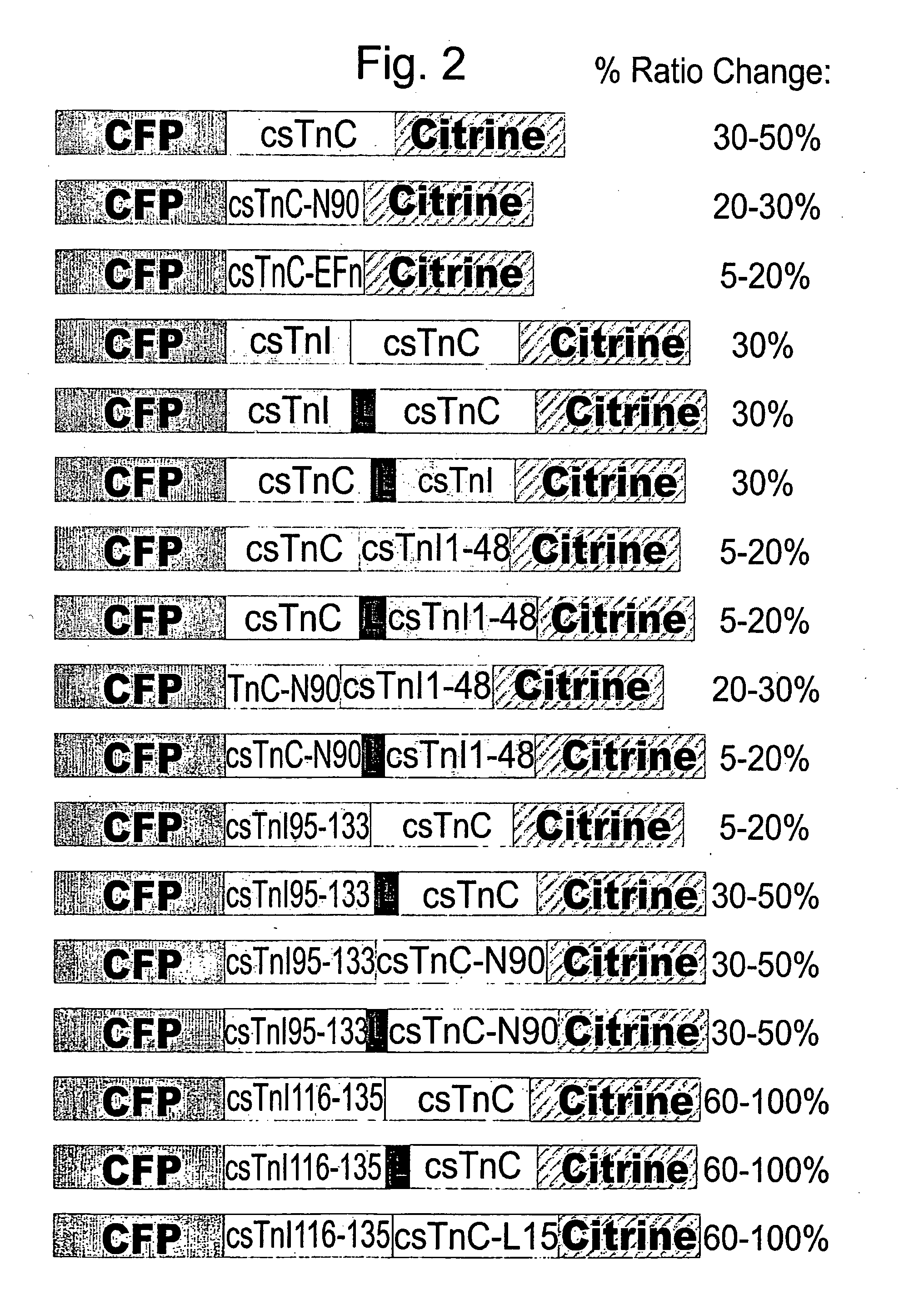Genetically encoded bioindicators of calcium-ions
- Summary
- Abstract
- Description
- Claims
- Application Information
AI Technical Summary
Benefits of technology
Problems solved by technology
Method used
Image
Examples
example 1
Gene Construction
[0115]Full length and truncated troponin C domains were obtained by PCR from the cDNA of chicken skeletal muscle troponin C (csTnC) and drosophila troponin C isoform 1 (TnC41C) using a sense primer containing an SphI site at the 5′ end and a reverse primer containing a SacI site at the 3′ end. Likewise, full length and truncated domains of human cardiac muscle troponin C (hcardTnC) were obtained from a cDNA sequence from which the intrinsic SacI site had to be removed first by oligonucleotid-directed mutagenesis, resulting in a silent mutation of the Glu135 codon (GAG to GAA). All troponin C DNA fragments were inserted between CFP and Citrine in the bacterial expression vector pRSETB (Invitrogen) carrying a CFP with an SphI site at the 3′ end and a Citrine with a SacI site at the 5′ end. A schematic representation of FRET occurring in ratiometric indicators based on troponin C variants is shown in FIG. 1. Calcium binding to the troponin C domain leads to a conformat...
example 2
Protein Expression, In Vitro Spectroscopy and Titrations
[0120]Proteins were expressed in bacteria using the T7 expression system in combination with the pRSETB plasmid carrying the fusion protein. Since the pRSETB plasmid also furnishes the fusion protein with an N-terminal polyhistidine tag, proteins could be purified from cleared cell lysates on nickel-chelate columns. Purified proteins were then subjected to in vitro fluorescence measurements in a Cary Eclipse fluorometer (Varian) equipped with a stopped flow RX2000 rapid kinetics accessory unit for kinetic measurements (Applied Photophysics). To obtain the percent ratio change of a protein, the fluorescence emission intensities of the FRET donor and the acceptor were measured at their respective emission maxima. Values were determined at zero calcium levels or at calcium saturation for each indicator. The Ca-free buffer contained an aliquot of the protein in 10 mM MOPS pH 7.5, 100 mM KCl, and 20 μM EGTA. In the second step, a so...
example 3
Functionality of TNC-Based Indicators in Live Cells
[0123]HEK-293 cells were transfected with lipofectin reagent (Invitrogen) and imaged two to four days later on a Zeiss Axiovert 35M microscope with a CCD camera (CoolSnap, Roper Scientific). Hippocampal neurons were prepared from 17 day old rat embryos, transfected by calcium phosphate precipitation 1 week after preparation, and imaged 2 days after transfection. The imaging setup was controlled by Metafluor 4.6 software (Universal Imaging). For ratio imaging, a 440 / 20 excitation filter, a 455 DCLP dichroic mirror and two emission filters (485 / 35 for CFP, 535 / 25 for Citrine) operated in a filter wheel (Sutter Instruments) were used. Constructs of the indicators with optimized Kozak consensus sequences for initiation of translation were expressed. Troponin C is a part of the troponin complex and usually not expressed as an isolated protein within the cytosol. It was therefore interesting and satisfying to see that our indicators showe...
PUM
| Property | Measurement | Unit |
|---|---|---|
| Fraction | aaaaa | aaaaa |
| Fraction | aaaaa | aaaaa |
| Fraction | aaaaa | aaaaa |
Abstract
Description
Claims
Application Information
 Login to View More
Login to View More - R&D
- Intellectual Property
- Life Sciences
- Materials
- Tech Scout
- Unparalleled Data Quality
- Higher Quality Content
- 60% Fewer Hallucinations
Browse by: Latest US Patents, China's latest patents, Technical Efficacy Thesaurus, Application Domain, Technology Topic, Popular Technical Reports.
© 2025 PatSnap. All rights reserved.Legal|Privacy policy|Modern Slavery Act Transparency Statement|Sitemap|About US| Contact US: help@patsnap.com



